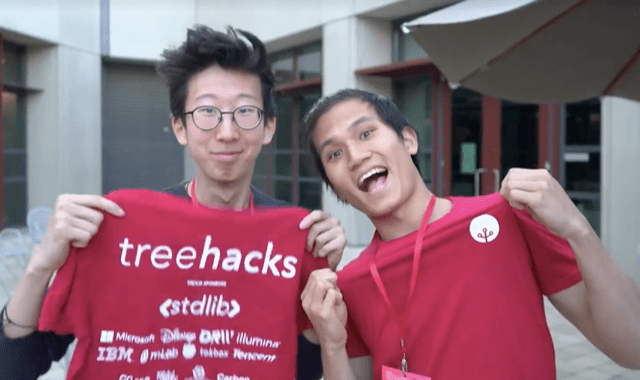TreeHacks, Stanford’s annual collegiate hackathon, returned for its fourth year from Feb. 16-18. The 36-hour event, which largely took place in the Jen-Hsun Huang Engineering Center, drew approximately 800 attendees from the Stanford community and beyond and was supported by Microsoft, Disney, IBM and other corporate sponsors.
Hackers’ projects could address issues related to security, energy and health — the three “verticals,” or specific markets, on which the hackathon focused. TreeHacks also partnered with Stanford Applied Security Group to host its first Capture the Flag (CTF) competition, in which hackers completed information security challenges in order to capture hidden “flags” and earn points.
“Overall, I was so happy with the event. I think my favorite part was walking around the judging expo and seeing the incredible hacks that people made over the weekend,” said Emily Cohen ’20, who co-directed the event alongside Cassandra Lin ’20 and Andrew Milich ’19. “It’s always especially exciting when we see a team who hadn’t met until the weekend of the hackathon come together, think of an idea and actually create it all during the event that we put together.”
TreeHacks awarded over $78,000 in prizes. Three grand prizes honored projects that demonstrated significant creative efforts, potential for social impact and technical aptitude. Computertop Desk, which uses a projector and computer vision to map desktop windows onto pieces of paper, won Most Creative Hack. The Ultimate Water Heater, an Internet of Things device that heats water with electromagnetic waves and reports water temperatures to users’ mobile devices, won Greatest Social Impact. NeuralHash, which uses adversarial deep learning — a type of machine learning — to encode digital signatures onto images, won Most Technically Challenging Hack.
“TreeHacks was a great experience because I had the chance to work with some really hardworking and awesome people,” said Evani Radiya-Dixit ’21, a member of the winning NeuralHash project. “I myself am amazed at how much I learned and what we were able to create and demo after just 36 hours.”
Three other grand prizes were awarded for each of the three verticals. Another prize was awarded for the CTF competition. Corporate sponsors also gave out awards for notable applications of their products in hackers’ projects.
When hacking ended on Sunday, 116 projects were submitted for judging. Teams presented their projects at an expo, where a team of judges evaluated the hacks on creativity, technical complexity and social impact. The judges then chose the top eight teams to demonstrate their hacks at the closing ceremony in front of a panel of three judges: founder and managing partner of Arbor Ventures, Melissa Guzy, founder and president of Tensyr, Bogdan Cocosel, and director of AI at Tesla, Andrej Karpathy.
TreeHacks offered resources for hackers with varying levels of experience coding. There were over 100 mentors who answered technical questions from hackers. The program also supplied HackPacks, which provided attendees with starter code to help simplify their projects. TreeHacks also hosted workshops that gave tutorials on different technologies.
Tom Knowles ’21, who is new to hackathons, said that the resources available at TreeHacks helped define his team’s project, Memorium, which allows users to have conversations with Alexa about past events and sorts them into happy and sad memories. Knowles, Tatiana Wu ’21, Luis Ulloa ’21 and Tassica Lim ’21 won the prize “Best Voice Experience Using Amazon Alexa,” an Amazon-sponsored award.
“We spoke to the [representatives] from Amazon and Microsoft, and the rep from Amazon was very useful in explaining what they’re looking for in a voice experience,” said Knowles. “The reps from Microsoft gave us the idea of using a sentiment analysis API on stuff that Alexa had.”
TreeHacks organizers emphasized community building as a core tenet of the program. Cohen described this additional focus as unique compared to other hackathons. She said that events like karaoke, a sunrise Dish hike, laser tag, performances from student groups — including the Stanford Band — and more helped attendees take a break from hacking.
“Some students during the hackathon want to hack all 36 hours, but others need a break and want an opportunity to meet the other hackers,” said Courtney Bond ’20, who worked on the Treehacks sponsorship team. “So we had…[these events] for them to get to know and understand the Stanford community.”
UC Davis sophomore and computer science major Sergei Chestakov, who attended TreeHacks, said that he values hackathons for the hands-on experience.
“I got into hackathons about a year and half ago, and seeing ideas come to life is inspiring,” Chestakov said. “You learn all these things in class, but you don’t always have the time to apply that knowledge. Hackathons push you to do that.”
Contact Sterling Alic at salic ‘at’ stanford.edu.
